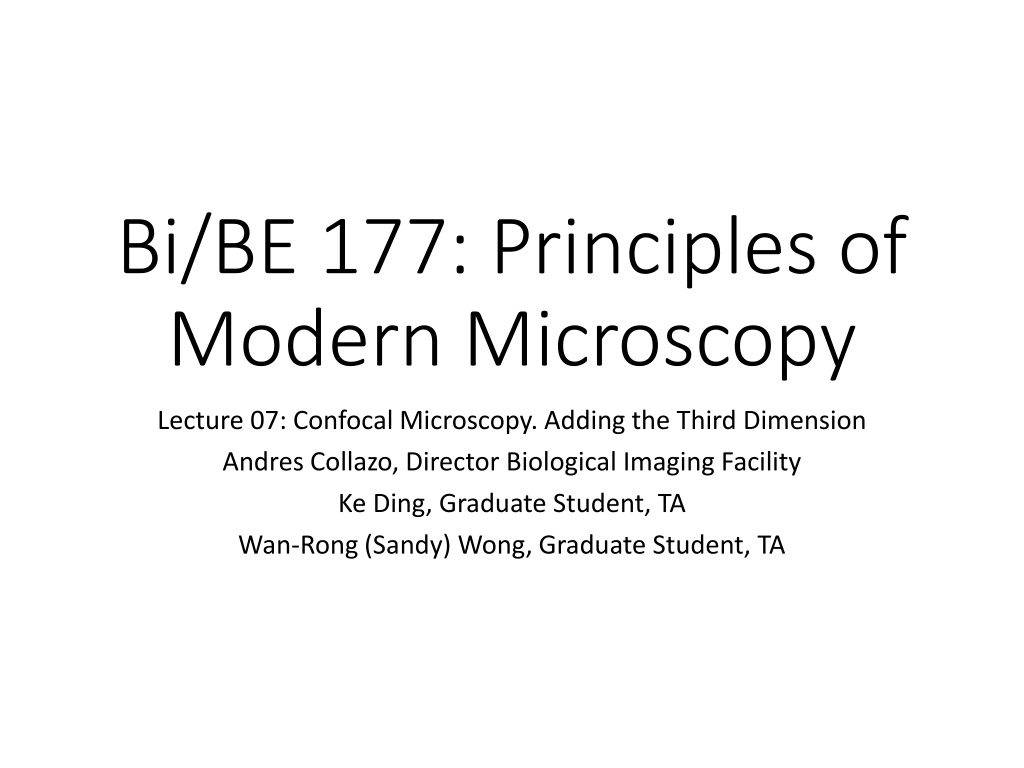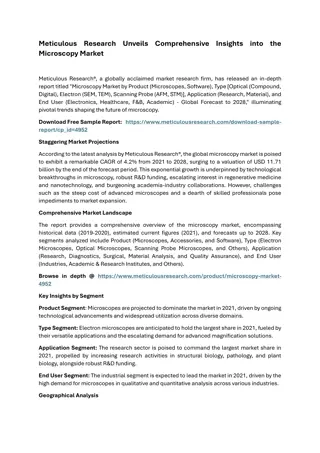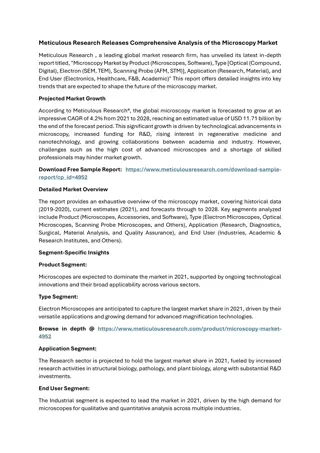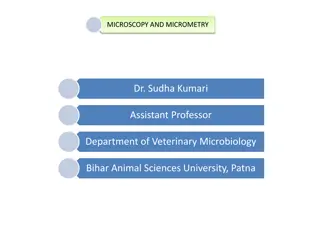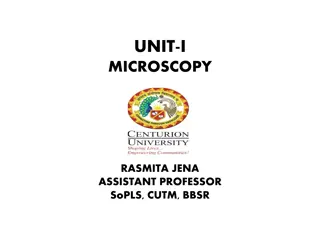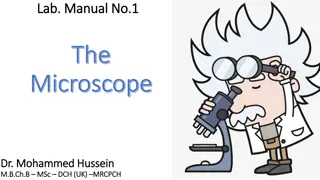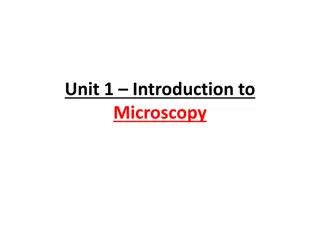Exploring Confocal Microscopy: Adding the Third Dimension
Delve into the world of confocal microscopy with Lecture 07 of Principles of Modern Microscopy. Learn about optical sectioning, wide-field imaging, confocal laser scanning, and more to enhance fluorescence in microscopy. Understand the methods of optical sectioning such as deconvolution, multi-photon laser scanning, spinning disk systems, and structured illumination microscopy. Discover the relationship between diffraction, Airy disk, and point spread function for advanced imaging techniques.
Download Presentation

Please find below an Image/Link to download the presentation.
The content on the website is provided AS IS for your information and personal use only. It may not be sold, licensed, or shared on other websites without obtaining consent from the author. Download presentation by click this link. If you encounter any issues during the download, it is possible that the publisher has removed the file from their server.
E N D
Presentation Transcript
Bi/BE 177: Principles of Modern Microscopy Lecture 07: Confocal Microscopy. Adding the Third Dimension Andres Collazo, Director Biological Imaging Facility Ke Ding, Graduate Student, TA Wan-Rong (Sandy) Wong, Graduate Student, TA
Lecture 7: Confocal Microscopy Optical Sectioning: adding the third dimension Wide-field Imaging Point Spread Function Deconvolution Confocal Laser Scanning Microscopy Confocal Aperture Optical aberrations Spinning disk confocal Two-photon Laser Scanning Microscopy Fluorescent proteins
Improve fluorescence with optical sectioning Wide-field microscopy Illuminating whole field of view Confocal microscopy Spot scanning Near-field microscopy For super-resolution TIRF Remember, typical compound microscope is not 3D, even though binocular
Overview of Optical sectioning Methods Deconvolution Point-Spread function (PSF) information is used to calculate light back to its origin Post processing of an image stack Confocal and Multi-photon Laser Scanning Microscopy Pinhole prevents out-of-focus light getting to the sensor(s) (PMT - Photomultiplier) Multi Photon does not require pinhole Spinning disk systems A large number of pinholes (used for excitation and emission) is used to prevent out-of- focus light getting to the camera Especially those using Nipkow disk and microlens Structured Illumination Microscopy (SIM) Light sheet fluorescence microscopy, also called selective/single plane illumination microscopy (SPIM)
Widefield imaging: entire field of view illuminated And projected onto a planar sensor
Relationship between diffraction, airy disk and point spread function Airy disk 2D Point spread function -3D Though often defined as the same that is not quite true
Point Spread Function is three dimensional Image of subdiffraction limit spot Subdiffraction limit spot https://micro.magnet.fsu.edu/primer/java/imageformation/depthoffield/index.html Thus, each spot in specimen will be blurred onto the sensor (Aperture and Missing Cone )
To reduce contribution of blurring to the image: Deconvolution Compute model of what might have generated the image Image blurred by PSF Compare and iterate Compute how model would be blurred by PSF Deconvolution depends on data from focal planes above and below focal plane being analyzed.
Image deconvolution Inputs: 3-D image stack 3-D PSF (bead image) Requires: Time Computer memory Artifacts? Algorithms so good now Note: z-axis blurring from the missing cone is minimized but not eliminated
Optical Sectioning even when 3D image stack is incomplete Deconvolution Confocal microscopy A A P Top: Macrophage - tubulin, actin & nucleus. Bottom: Imaginal disc -tubulin, -tubulin. Neural Gata-2 Promoter GFP-Transgenic Zebrafish; with Shuo Lin, UCLA
Optical Sectioning: Increased Contrast and Sharpness. Examples: Zebrafish images, Inner ear Zebrafish wide-field, optical section Confocal microscope Z-stack
How else to fill in the missing cone? Need more data in the Z-axis --> Confocal microscopy PMT Detector Detection Pinhole Confocal pinholes Excitation Laser Dichroic Beam Splitter Excitation Pinhole Objective Conjugate Focal Planes
Confocal Microscopy just a form of Fluorescence Microscopy www.olympusfluoview.com
Confocal Microscopy (Minsky, 1957) Yes that Marvin Minsky of MIT AI (Artificial Intelligence) lab fame. Three confocal places
Pinhole: Axial Filtering Identical Lens Focal Points
Aperture trims the PSF: increased resolution in XY plane How N.A. and air disk effects resolution But at a cost in brightness: Thinner section means less labeled material in image Aperture rejects some in focus light Subtle scattering or distortion rejects more light
Resolution, Signal and Pinhole Diameter Best Resolution Best Signal to Noise http://depts.washington.edu/keck/leica/pinhole.htm
Why does confocal add depth discrimination? Light projected on a single spot in the specimen Spatial filter in front of the detector Good: detection falls off by the distance from the focus squared Good: excitation falls off by the distance from the focus squared Bad: illumination of regions that are not used to generate an image Optical sectioning Combined, sensitivity falls off by (distance from the focus)4
But this arrangement generates an image of only one point in the specimen Only a single point is imaged at a time. Detector signal must be decoded by a computer to reconstruct image. Imaging point needs to be scanned somehow.
Scan Specimen Good: Microscope works on axis Best correction for optical aberrations Most uniform light collection efficiency Bad: Slow Sloshes specimen
Scan Microscope Head Good: Specimen doesn t move Microscope works on axis Best correction for optical aberrations Most uniform light collection efficiency Bad: Slow Optics can be more complicated
Scan Laser Good: Faster Specimen moves slowly less sloshing Bad: Very high requirements on objective Light collection may be non-uniform off-axis More complicated
Confocal Terminology LSCM Laser Scanning Confocal Microscopy CLSM Confocal Laser Scanning Microscopy CSLM Confocal Scanning Laser Microscopy LSM Laser Scanning Microscopy
Optical Aberrations: Imperfections in optical systems Spherical Chromatic (blue=shorter wavelength) Curvature of field
Spherical Aberration Zone of Confusion
Higher index of refraction results in shorter f Chromatic Aberration Lateral (magnification) Axial (focus shift) f Shift of focus i o Change in magnification
Lateral chromatic aberration - light misses aperture Detector
Curvature of field: Flat object does not project a flat image f i o Results in a port hole image: dimmer at edges
Optical Aberrations: Image dimmer with depth Image dimmer at edges Image resolution compromised N.A. = sin Can t fight losses with smaller NA Remember N.A. and image brightness Epifluorescence Brightness = fn (NA4 / magnification2) 10x 0.5 NA is 8 times brighter than 10x 0.3NA
Optical Aberrations: Image dimmer with depth Image dimmer at edges Image resolution compromised N.A. = sin Can t fight losses with smaller NA NA also has a major effect on image resolution Minimum resolvable distance dmin = 1.22 / (NA objective +NA condenser) Larger N.A. can collect higher order rays
Best way to deal with Aberrations is to have high performance objective High Numerical Aperture Water immersion for live cell imaging Correction for spherical aberrations Flat field correction Chromatically corrected over many different wavelengths Transmit UV and IR Two photon
How to scan the laser beam? Place galvanometer mirror at the telecentric point All light travels through the same zone Angle at which the light travels dictates the position in the specimen plane Not imaging but illumination conjugate plane. Telecentric Plane
How to scan the laser beam? Place galvanometer mirror at the telecentric point laser Modern closed-loop galvanometer-driven laser scanning mirror from Scanlab
Position is critical Place galvanometer mirror at the telecentric point laser If not at telecentric point, Spherical aberration results How can two mirrors be at the same point??
Scanners can introduce optical aberrations Place galvanometer mirror at the telecentric point laser If not at telecentric point, Spherical aberration results How can two mirrors be at the same point?? Optical relay (without aberration)
Problem: Optical aberrations from simple lens systems f i o
Simple pair of lenses can minimize problem (equal and opposite distortions) Focal Point Focal Point f
1:1 Image relay Focal Point f
Position is critical Place galvanometer mirror AT AT the telecentric point Optically two mirrors can be at the same point Optical relay (without aberration)
Limitations: Phototoxicity Sample is continuously exposed to light. Weaker signal within sample requires stronger excitation and causes more toxicity.
Limitations: Photobleaching Scanning causes repeated exposure above and below.
How else to do confocal microscopy? Confocal microscopes can be slow. Can we go faster?
Tandem spinning disk scanner EMCCD or CMOS Camera Laser Illumination through this side Detection through this side Alignment is critical Most of light hits mask not hole
Nipkow disk ~1% pass
Nipkow disk with microlenses >>1% pass Yokogawa
Nipkow disk with microlenses http://zeiss-campus.magnet.fsu.edu/tutorials/spinningdisk/yokogawa/index.html
Optical sectioning without an aperture? Two-Photon laser-scanning microscopy Pinhole aperture
